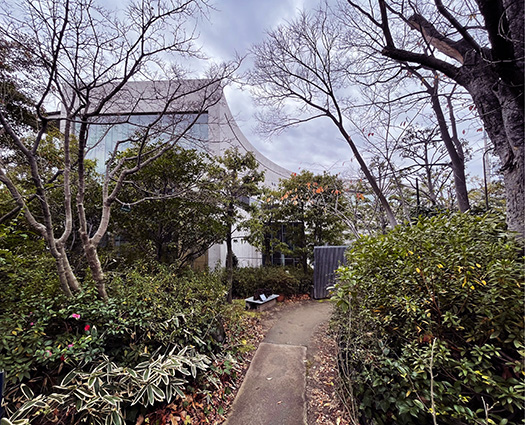
きのう日本的な花鳥風月的「名庭園」志向についてふれた。
温暖地日本の「住居」の規範伝統、その高級表現を考えて行ったときに、縁を介した作庭というものを「愛でる」床の間付きの座敷という結論が、和の普遍的志向かと思えるワケ。
で、日本の生活文化性のなかに、そういった花鳥風月とそれを感受する精神性を重視するという大きな領域が存在すると見切れるのではないかと。そういう「わび寂び」のような精神の地平を獲得した人間性に、はるかな優越性を認めるような精神文化の風土だと。
そうした作庭とそれを愛でる暮らしようというのは、北海道でもそれなりに試みられはしたけれど、それは自ずと「破綻」する。開放的な縁側を介して美感あふれる作庭をした住宅について側聞したことがあるが、必然的に居間に大開口が出来て極度の寒冷が襲ってきて、さらに縁の部分に掛けた軽量級の屋根が冬期の積雪過重に耐えられなかったという。
冬期、積雪開始が12月として、冬中〜3月いっぱいは堆雪でもちろん庭木はみごとに雪に被覆され、毎日そういう単調な堆雪場所を眺め暮らしていたと話されていた。春になってもそのまますぐに庭木を楽しめるワケではなく、冬囲いを解放させて樹木の再生緑化を待つことになる。そもそも常緑の繊細な緑には、そういう越冬力はあまり期待できない。
多大な労力を掛けて、本当に楽しめそうなのは夏期のほんの数ヶ月。
北海道と積雪条件では似た環境とも言える会津の大名庭園の風雅な建築は積雪過重で何度も破綻し、たいへんなコストを掛けて、何度も建て替え続けたとされている。
そんな「名庭園」志向に対して、写真の東大阪の司馬遼太郎記念館としていま公開されている作家の家では、その庭に地元地域のあるがままの自然な植生が植え込まれていた。また各地のファンの方から名もない雑木も氏の「数寄」に合わせて贈呈されたりしていたとされる。司馬遼太郎氏はそういう庭をこよなく愛していたとのこと。
北海道でもあり得るのはこういう作庭の志向性だろう。しかし花より団子の北海道人は、BBQのステージとしたり、家庭菜園化することが多いとコメントを寄せられた方もいた。
家庭菜園では家族のリクエストでたとえばアスパラなどのお気に入り野菜類が植え込まれるので、やはりコンセプトは「花より団子」一択なのだろうか。
しかしそれ以上に、北海道ではチマチマと作庭して風雅なミニ「自然」を楽しむよりも、ちょっと目を転ずれば広やかな大空と、大自然のいとなみが目に飛び込んできてくれる。その魅力に比べれば、北海道人はわびさび的な作庭には興味が向かないのだと思う。
耽美的な大名庭園、深遠なわびさびを求める風雅な志向性は、やはり「ムリ」一択。なんとも身も蓋もない、というところだろうか?
English version⬇
The wooded “garden” of the area favored by Ryotaro Shiba.
The “dumpling” orientation is more toward vegetable gardens to enjoy greenery while satisfying one’s appetite rather than elegant gardens, and more toward a dynamic BBQ stage than a flower garden. This kind of orientation may be possible somewhere in between. The garden
Yesterday, I wrote about the Japanese “famous garden” orientation in the “Kacho-fu-getsu” style.
When I think about the normative tradition of “residence” in warm climate Japan and its high-class expression, I conclude that a tatami room with an alcove for “appreciating” the garden through an open veranda is a universal orientation of the Japanese style.
I believe that there is a large area of Japanese culture that emphasizes the spirituality of appreciating the beauty of flowers, birds, wind, and the moon. It is a spiritual and cultural climate that recognizes the superiority of humanity that has attained such a spiritual horizon of “wabi sabi.
Such gardens and a way of living that enjoys them were tried to a certain extent in Hokkaido, but they naturally “broke down. I once heard about a house with a beautifully designed garden on the open porch, but the living room inevitably had a large opening, which was extremely cold, and the lightweight roof over the porch could not withstand the excessive snow accumulation during the winter.
The garden trees were covered with snow from mid-winter to the end of March, and he used to look at the monotonous snow-covered area every day. In the spring, the garden trees are not immediately ready for enjoyment, but rather, they must be released from their winter enclosure and wait for the trees to regenerate and green up. In the first place, such wintering power cannot be expected from delicate evergreen plants.
After a great deal of effort, the trees can only be truly enjoyed for a few months during the summer season.
The elegant architecture of the Daimyo Gardens in Aizu, an environment similar to that of Hokkaido in terms of snow accumulation, is said to have failed many times due to excessive snow accumulation, and had to be rebuilt many times at great cost.
In contrast to such “famous gardens,” the writer’s house, which is now open to the public as the Ryotaro Shiba Memorial Museum in Higashi Osaka, as shown in the photo, has natural vegetation of the local area planted in the garden as it is. Fans from all over the world are said to have presented him with unnamed trees and shrubs for his “sukiyos”. Ryotaro Shiba loved such gardens.
This kind of garden is also possible in Hokkaido. However, one commenter said that Hokkaido people, who prefer dumplings to flowers, often use their gardens as a stage for BBQs or as a vegetable garden.
In the vegetable garden, favorite vegetables such as asparagus are planted at the request of the family, so perhaps the concept of “dumplings rather than flowers” is still the only choice.
But more than that, in Hokkaido, rather than enjoying the elegant miniature “nature” of a small garden, one can just turn one’s eyes and see the wide open sky and the natural beauty of nature. Compared to the charm of such gardens, Hokkaido people are not interested in wabi-sabi style gardens.
For the aesthetic daimyo’s garden and the elegant orientation that seeks the profound wabi-sabi, the “muri” is the only choice. It’s a bit of a stretch, isn’t it?
Posted on 5月 28th, 2024 by 三木 奎吾
Filed under: 住宅取材&ウラ話







コメントを投稿
「※誹謗中傷や、悪意のある書き込み、営利目的などのコメントを防ぐために、投稿された全てのコメントは一時的に保留されますのでご了承ください。」
You must be logged in to post a comment.